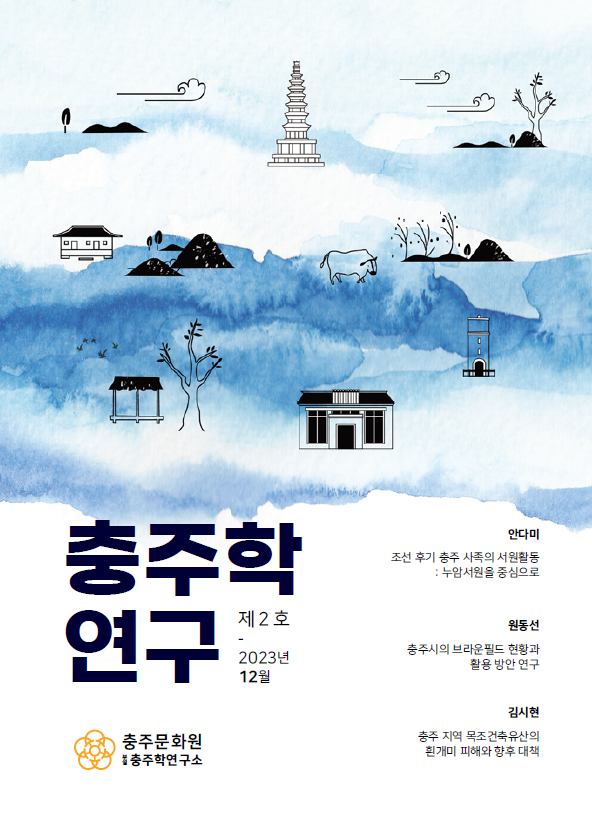충주 지역 목조건축유산의 흰개미 피해와 향후 대책
Analysis of termite damage to wooden built heritages in Chungju and countermeasure
- 충주문화원 부설 충주학연구소
- 충주학연구
- 2023년 제2호
-
2023.12107 - 139 (33 pages)
- 0

충주는 한반도의 중앙에 위치하며 오랜 기간 인근 지역의 중심지로 기능하여 현재까지 다수의 목조문화유산들이 남아 있다. 이들은 흰개미 등 생물학적 요인들에 의해 손상될 위험이 있지만 관련된 연구는 수행된 바 없다. 따라서 이번 연구에서는 충주 지역 목조문화유산 9건을 대상으로 흰개미 피해 현황과 주변 환경을 분석하고 향후 관리 방안을 제안하고자 하였다. 조사 결과 충주 향교, 제금당, 한남군 사당에서 흰개미 피해가 확인되었다. 충주향교는 명륜당과 대성전 등 중심 건물들의 상태는 양호하였지만 외곽의 문 3개소에서 흰개미 피해가 확인되었다. 제금당에서는 건물 내부와 배면의 기둥 및 하인방 3개소에서 흰개미 피해가 확인되었다. 건물 내부에서 흰개미 유시충 사체들이 발견되어 이미 흰개미 피해가 상당히 진행 되었으며, 건물 주변에 성숙한 흰개미 군체가 서식하고 있을 것으로 보인다. 한남군 사당에서는 기둥 1기에서 흰개미 피해가 확인되었다. 흰개미 피해가 발생한 건물들은 당해문화유산 뿐 아니라 주변의 건물까지 포함하여 군체제거 등 방제처리를 실시하고, 주기적인 일상관리와 모니터링이 필요하다. 또한 향후 당해문화유산의 해체보수나 문화유산 주변에 목조건축물을 신축할 때는 흰개미 유입 방지 장치(Physical barrier)의 설치가 필요하다. 흰개미의 거시적인 분포 범위와 활동 기간은 온도에 의해 결정된다. 충주 지역의 최근 50년(1973~2022) 간 기온 변화를 분석하고 흰개미가 지상에서 활발히 활동할 수 있는 기간을 추정하였다. 그 결과 연평균 기온은 10.9℃에서 12.2℃로 1.3℃ 증가하였다. 수집된 일평균 기온 자료로 추정한 연간 흰개미 활동 가능 일수는 1973~1982년 201일에서 2013~2022년 213일로 12일 증가하였다. 충주 지역의 흰개미들은 지상에서 3월 중순부터 11월 중순까지 활동할 것으로 추정된다. 이번 연구는 충주 지역 목조문화유산의 보존관리를 위해 활용될 수 있다. 또한 특정 지역의 목조문화유산을 대상으로 흰개미 피해 현황 및 관련 기온 변화를 분석한 첫 사례로 향후 다른 지역에서도 적용될 수 있는 연구 방법을 제시하였다는 점에서 의미가 있다.
Chungju is located in the center region of the Korean Peninsula and has long served as a regional center. As a result, there are a number of wooden cultural heritages. They are at risk of being damaged by biological factors such as termites, but no relevant studies have been conducted. Therefore, this study aimed to analyze current termite damages and surrounding environment of nine wooden cultural heritages in Chungju and propose future management methods. As a result, termite damage was confirmed at Chungjuhyanggyo Local Confucian School, Jegeumdang, and Hannamgun Shrine. At Chungju hyanggyo, the central buildings such as Myeongryundang Lecture Hall and Daeseongjeon Shrine were in good condition, but termite damage was confirmed at three outer main gaits. At Jegeumdang, termite damage was confirmed on the pillars and Hainbang(Lumber hung horizontally between pillars) in the interior of the buildings and back. Unlikely other buildings, dead termite alates were found inside the building. It suggest that there is a mature termite colony around the building. At the Hannamgun Shrine, termite damage was confirmed in one column. Buildings with termite damage will require termite control such as baiting. Termite controls should be conducted not only termite-infested buildings but also adjacent buildings. And it also requires daily management and periodic monitoring. In addition, it is necessary to install a physical barrier when dismantling and repairing the cultural heritage or constructing a wooden building around the cultural property in the future. The macroscopic distribution range and activity period of termites are determined by temperature. I analyzed temperature changes over the last 50 years (1973~2022) in the Chungju region and estimated the period during which termites can be active on the ground. The results showed that the average annual temperature increased by 1.3℃, from 10.9℃ to 12.2℃. The number of termite active days per year increased by 12 days, from 201 days in 1973~1982 to 213 days in 2013~2022. Termites in the Chungju area are estimated to be active above ground from mid-March to mid- November. The effectiveness of termite monitoring and control may vary depending on the time of year, so these results should be used as a guide for field application. This study can be utilized for conservation management of wooden cultural heritages in Chungju. And it is also significant in that it is the first case of analyzing termite damage and related temperature changes on wooden cultural heritages in a specific region, and suggests a research method that can be applied to other regions in the future.
Ⅰ. 머리말
Ⅱ. 충주 지역 목조문화유산 흰개미 피해 현황과 관리 방안
Ⅲ. 충주 지역 기온과 흰개미 활동 가능 일수의 변화
Ⅳ. 맺음말
(0)
(0)